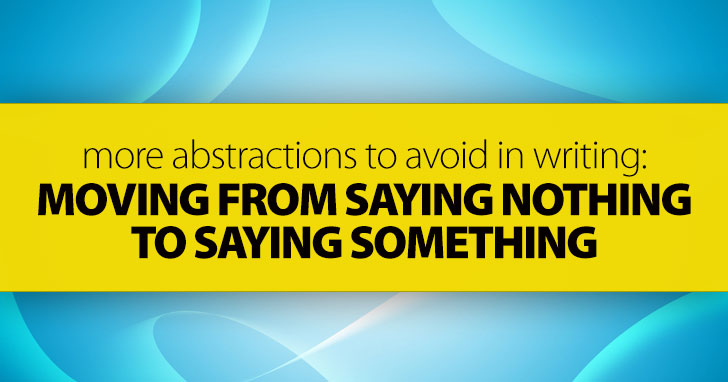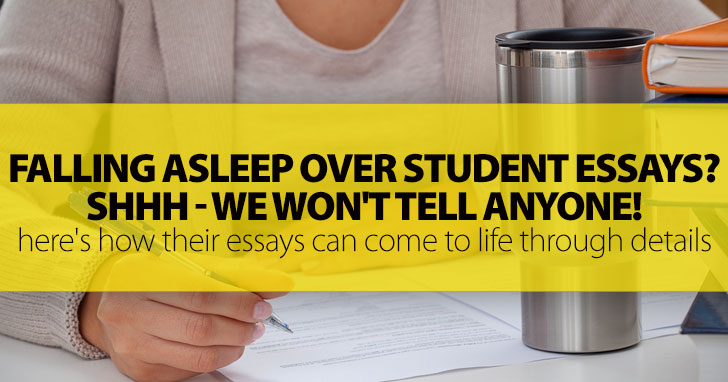More Abstractions to Avoid in Writing: Moving from Saying Nothing to Saying Something


At first I thought it was simply fatigue. It is tiring and requires reading hundreds of papers to teach several composition classes in a term. Then I thought it was boredom. Reading, over and over again, that technology has improved our lives immensely is pretty boring. Then I realized it was escape. Going to sleep is actually a pretty good defense against reading the unsupported and vague claims--over and over-- that “technology” is “wonderful” and that “society” and “the media” are working--sometimes in tandem--to damage “youth.”
However, a better strategy than sleeping would be to teach students how to develop their points more specifically and vividly so that they are not putting their readers into snooze mode. There are some methods to do this:

There are some terms that are real snoozers, guaranteed to get the eyes drooping: “society,” “the media,” “technology,” “issue,” “the government” are a few. These terms are used without much thought on the part of the writer, which is why they cause brain numbness in the reader. Whenever the writer catches herself using one of these terms, she should ask herself about what she really means: What exactly does “society” mean in the context I’m using it? Do I mean my country? The state of California? My school or neighborhood? By narrowing and defining terms the writing begins to be more vivid: “Twenty-first century America has been impacted greatly by the smart phone” is still not a really compelling thesis, but it is certainly stronger than “Technology has really affected current society.”
This method of the writer thinking about and querying what she really means, besides working well in defining and narrowing terms, works equally well in examining unsupported claims. Students sometimes use vague or unsupported claims because they are repeating something often -heard and which they have not given much if any thought: e.g., “Guns don’t kill people; people kill people” is a standard argument against gun control in the United States which finds its way into many student papers. Teaching students to query what this claim means by asking questions about its different parts--e.g., “What sorts of activities are guns used for besides killing? Under what circumstances can a gun kill without a human agent?”--will get students to consider what they are saying and what it really means.
Once the student has defined her terms adequately--returning to the topic of the massive effects of smart phones on the twenty-first century, for example--then the student’s job becomes to explain not just the terms but the claim itself. This is an opportunity for developing audience awareness, the sense that the writer is indeed writing the essay for someone to actually read it--maybe even engage with--not just for the instructor to glance at with glazed eyes and scrawl a “C-” or “D+” at the top (depending on how tired she is). Ask students, for example, to explain to the reader who has no smart phone (there are such people still around) about the overwhelming influences of the phone on our lives. What are some of these massive effects? How have they impacted the 21st century in particular? How is life now different from the way it was before the invention of the phone? Who is most affected by the device? This forces students to really consider the claim in order to explain it to the reader, which in the process begins to develop the student’s work. In the process, the student also gets more engaged with the writing process itself, as it begins to occur to her she is writing for this specific purpose of explaining the smart phone to a specific audience who isn’t informed already on the topic--making this an authentic act of communication, not just a rote exercise the teacher is putting her through because it’s the kind of incomprehensible thing teachers do. Students often even go beyond considering the hypothetical uninformed yet intelligent audience to thinking of an actual audience--a place to post the essay online, for example, or a school or community newsletter it might be published in.
In the process of explaining what she really means, the student will almost of necessity begin using personal examples from her own life and lives of her associates to further support the point, in this case of the smart phone and its life-altering effects. This will further develop her work, making it more compelling and concrete to the reader. Also at this time, the student will on her own begin to notice some of the disadvantages of the smart phone--its distracting, addictive nature, for example--and begin to develop a counterpoint, usually necessary for really strong writing and critical thinking, demonstrating that the writer has thoroughly considered the matter.
As students get further into the topic, they will also probably on their own--or maybe with some instructor prompting--begin to consider how the topic goes beyond themselves and what experts, such as sociologists and psychologists, are saying on the topic of the effects of electronic devices such as the smart phone on the culture as a whole as well as the individual. This will lead students to doing some research on the topic, especially if instructors ask that students add quotes and citations from experts in later drafts of a work. In the process of doing some research, students begin to understand fully the depth and breadth of a topic as well as learning some basic research and citation skills. The process of developing an essay as at this point becomes a mini-introduction to academic writing in considering an audience, addressing various points of view, and researching the existing dialogue on the topic, and learning to quote and cite source material.
Teaching students to really think about and develop their essays can be a challenge because it involves teaching a number of critical thinking, academic, and research skills that go beyond the immediate paper. However, the rewards and end result of introducing students to academic writing are enormous.